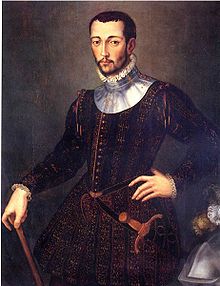Tariq Kimepra
His Grace The Earl of Kamalbia | |
|---|---|
 The Earl of Kamalbia | |
| Personal details | |
| Born | 16 February 1570 Cadenza, Cadenza |
| Died | 21 November 1649 (aged 79) Cadenza, Cadenza |
| Occupation | Nobleman and general |
Tariq Kimepra, 1st Earl of Kamalbia (16 February 1570-21 November 1649) was a Cadenzan commander and nobleman. He was born into a merchant family in the nation's capital, but after his elder brother inherited the family shipping fleet he entered the navy as a commissioned officer. He proved an able commander and, by the time of the War of the Magpie and the Dragon, had received command of one of the republic's fleets. Kimepra was sent to southern Kamalbia, then a territory of the Empire of Exponent, which he conquered after a lengthy land campaign. He then entrenched himself and successfully repelled efforts to restore Exponential control at Ialica and by subsequent expeditions. Kamalbia was left to Cadenza in the peace settlement, and Kimepra was assigned as its governor. In 1620 he was elected to the rank of earl of Khamalb, and the position remained within his family until the cession of the territory to Berique in 1814 at the conclusion of the Bernadottic Wars.
Legacy
Kimepra has been memorialised differently in Cadenzan histories and those from Hesperidesia and Scottopia. In Cadenza, he is often portrayed as an exceptional military leader who overcame Exponential resistance in Kamalbia against overwhelming odds. Praise for him outside of Cadenza is more restrained: Exponential (and, later, Confederate) histories characterise him as a competent commander whose strength was in his organisational ability rather than as a leader or tactician. The success of his Long March is attributed to his logistical expertise rather than any particular achievements in combat; historians note that the Siege of Castrum Tiberium was won despite Kimepra's failure to take its citadel and that his victory at Ialica was mostly the product of a better-armed force against more numerous militias and tribesmen.